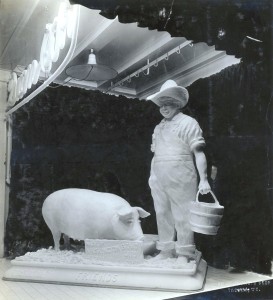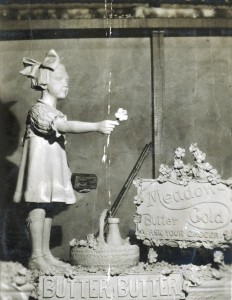 These statues, entitled Friends, by J. E. Wallace, were composed of lard. NSHS RG2158-15-1
These statues, entitled Friends, by J. E. Wallace, were composed of lard. NSHS RG2158-15-1
In the late nineteenth and early twentieth centuries, butter art was often featured at state and national fairs. The United States Centennial Exhibition, held in Philadelphia in 1876, included a butter sculpture, the bust of a woman, entitled Dreaming Iolanthe, which was widely admired and imitated. In the 1890s, leaders of the rapidly expanding dairy industry found butter art a new way to advertise their products. A small number of artists began to specialize in sculpting butter, sometimes using lard, a less expensive alternative.
Among them was J. E. Wallace, born in 1882, who began his career in the early 1910s as a sculptor and taxidermist. He lived in Lincoln and Hastings while providing butter statuary for fairs in this state as well as many others, including Florida, Georgia, Iowa, Kansas, Kentucky, Illinois, New York, Ohio, Tennessee, Texas, and Wisconsin. Butter cows, cows with milkmaids, or little boys with calves were popular subjects, but he also supplied butter statues of historical figures such as the equestrian Old Hickory, depicting Andrew Jackson, for the 1922 Tennessee State Fair.
About 1923 Wallace moved from Lincoln to Hastings, where he donated his labor to make a butter sculpture for the Adams County Fair. This would be the first time, he said, that he had worked for a fair smaller than a state or national one. Several local creameries supplied the butter. A new refrigerated glass case installed at the fairgrounds made possible the display of a life-sized butter sculpture of a Jersey cow.
The Hastings Daily Tribune said on July 2, 1923: “The refrigerator for the butter sculptured cow, which J. E. Wallace will prepare for the fair, is now completed in Agriculture Hall. It will not only contain the butter sculpture, but will have a space for perishable articles entered in the various agricultural exhibits. One side of the refrigerator is of glass and measures 66 x 73 inches. It will require a ton of ice to fill it to capacity.” As soon as Wallace finished the six-hundred-pound sculpture for the Adams County Fair, he left for Montreal, where he sculpted another butter cow for an international dairy convention. He later moved to Chicago and spent his last years in Florida, where he died in 1956.
The heyday of butter sculpturing was about 1890 to 1930, but such sculptures are still a popular attraction at agricultural fairs, on banquet tables, and as decorative butter patties.
Read more articles from the July/August/September issue of Nebraska History News, available online as a PDF at the Nebraska State Historical Society’s website or as a benefit of membership in the NSHS. Both full members and subscription-only members receive four issues yearly of Nebraska History News and Nebraska History magazine.– Patricia C. Gaster, Assistant Editor / Publications




